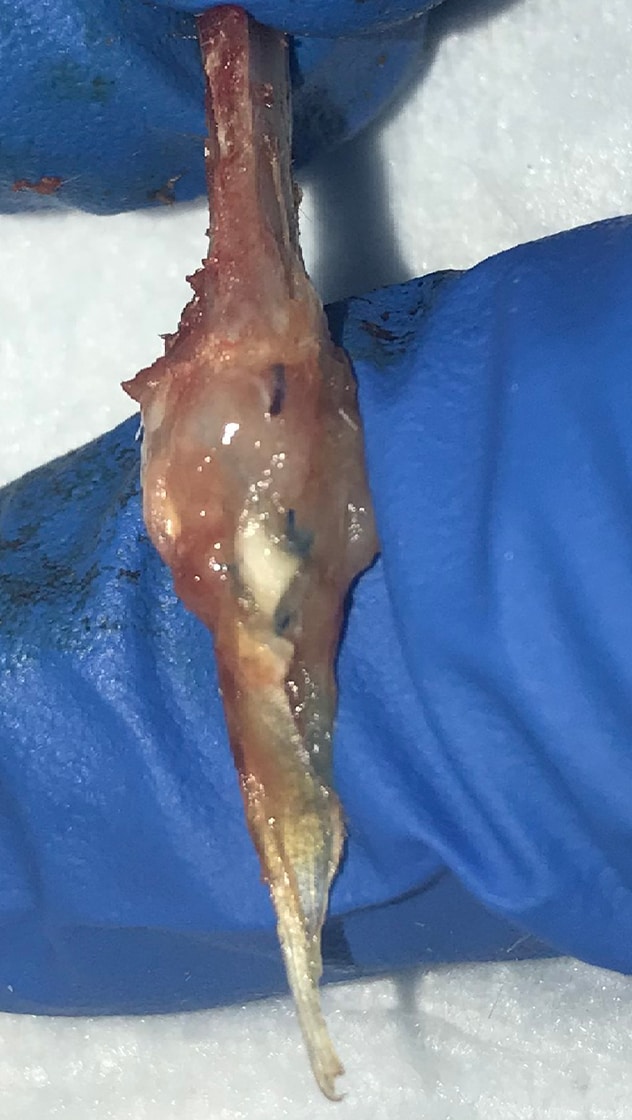Feb. 20, 2021
Despite recent improvements in surgical techniques and materials, approximately 25% of rotator cuff injuries fail to heal. Mayo Clinic is pursuing a regenerative medicine approach for improved treatment of these debilitating injuries.
"We have come a long way over the last 20 years from a mechanical engineering standpoint, with new kinds of anchors, suture materials and surgical techniques. But now we're realizing that the problem isn't mechanical — it's biologic," says John M. Tokish, M.D., an orthopedic surgeon at Mayo Clinic's campus in Phoenix/Scottsdale, Arizona.
Rotator cuff reconstruction using electrospun patch

Rotator cuff reconstruction using electrospun patch
Photograph of a laboratory model shows Mayo Clinic's experimental rotator cuff reconstruction using an electrospun patch.
Mayo's Center for Regenerative Biotherapeutics is working to develop electrospun fibers that, when surgically inserted, can promote tendon healing. Having created fiber structures in the laboratory that mimic the native tendon, the researchers are using animal models to investigate ways to embed growth factor products in those patches.
"Because of the orthobiologics revolution, we're beginning to understand the basic science behind what exactly signals a tendon to heal," Dr. Tokish says. "We've learned that we can add adjunctive materials that provide the necessary biochemical environment to get that tendon to regenerate. That used to be science fiction. But for now, at least in the lab, it's reality."
Promoting tendon healing and regeneration
Electrospinning is used to create fibers that, like a tendon's fibers, are measured on the nanolevel. The fibers can be arranged in varying directions.
"We know that the ability of tissues to regenerate often depends on the direction of their fibers," Dr. Tokish says. "Electrospinning allows us to place materials that are commonly used, and biologically accepted, within a magnetic field. Depending on the magnet's field strength and the direction of its spin, we can create nanofibers to be layered parallel to each other or intersecting, or really in any shape and direction we want. In the laboratory we can use a number of these different complementary fields to create a structure that mimics the native tendon."
Various combinations of fibers are being tested in rat models developed in conjunction with Arizona State University. Before insertion into the models, the fiber patches are imbued with various growth factor products.
"What's really exciting is that we can pre-soak the patch in factors complementary to the individual tendon zones that we need," Dr. Tokish says. "If it's muscle, we can embed factors that promote muscle growth in that area of the patch. If it's the calcified cartilage layer on the bone, we can embed factors that encourage that sort of regeneration into that portion of the patch."
In addition to providing necessary growth factors, the adjunctive materials may well be able to change the tendon's biochemical environment. "We've learned that these materials can encourage the body's own medicinal signaling cells to be recruited to the area of injury or degenerative tearing and provide the necessary environment for the tendon to regenerate," Dr. Tokish says. "When we are eventually able to insert the patch into human patients, it may act as a scaffold to encourage not only healing but also regeneration."
The goal is to apply the system to the treatment of both irreparable tears and severe tendinopathy. "In patients with irreparable tears, the patch by itself or in conjunction with other technologies we currently use may help that new tendon to be incorporated in the body and patients to regain previous function," Dr. Tokish says.
For patients with severely damaged yet repairable tendons, the biologic system might boost healing and safeguard the surgical repair. "We see a lot of patients in the younger demographic — between the ages of 40 and 60 — who have large rotator tears that are difficult to heal. Unfortunately, the reverse shoulder arthroplasty, which has revolutionized care for older patients, isn't a good option for younger people," Dr. Tokish says. "We are some ways away yet from human trials. But we feel that augmenting tendon healing through the regenerative medicine field may be the missing key that will help us to better treat rotator cuff tears."